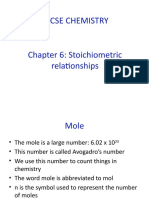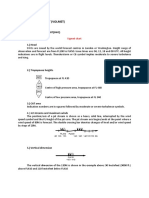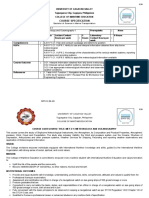DWATCHQUIZ1&2
DWATCHQUIZ1&2
Uploaded by
Evangeline TupazCopyright:
Available Formats
DWATCHQUIZ1&2
DWATCHQUIZ1&2
Uploaded by
Evangeline TupazCopyright
Available Formats
Share this document
Did you find this document useful?
Is this content inappropriate?
Copyright:
Available Formats
DWATCHQUIZ1&2
DWATCHQUIZ1&2
Uploaded by
Evangeline TupazCopyright:
Available Formats
DWATCH
TAKE HOME LONG QUIZ #1:
DIRECTIONS:
-25 item, 50PTS multiple choice questions by choosing the letter of the correct answer.
-Upon choosing your answer… explain/ justify your answer by citing the COLREGs.
-LATE SUBMISSION WILL RESULT TO SCORE OF 49%
EXAMPLE:
__D___1. The International Rules of the Road apply:
a.To all waters which are not inland waters.
b.Only to waters outside the territorial waters of the US.
c.Only to waters where foreign vessels travel.
d.Upon the high seas and connecting waters navigable by
seagoing vessels.
ANSWER: RULE 1, as it states that the rules of the road applies to vessels upon high seas and
connecting waters navigable by seagoing vessels
START HERE: 2 PTS PER QUESTION
_____1. These Rules shall apply to all vessels upon _________ connected
there with navigable by seagoing vessels.
I. The high seas II. In all waters
a. I and II c. both I and II
b. II only d. neither I nor II
ANSWER: A
_____2. Nothing in these rules shall interfere with the operation of special
rules made by an appropriate authority for _________ connected
with the high seas and navigable by seagoing vessels. Such special
rules shall conform as closely as possible to these Rules.
I. Roadsteads and harbors
II. Rivers
III.Lakes or inland waterways
a.I and II c. I and III
b.II and III d. I, II and III
ANSWER: D
_____3. Which statements is TRUE about the Navigation Rules?
a.The Rules require the vessels to comply with the
Traffic Separation Scheme Regulations
b.The Rules use the term “safe speed”.
c.The Rules Permit a stand-on vessel to take action
prior to being in extremis.
d.All of the above are correct.
ANSWER: D
_____4. You are on a vessel that cannot comply with the spacing requirement for
masthead lights due to the nature of the vessel’s function.
What is required in this situation?
a.The vessel must carry only the lights that comply with the rules,
the others may be omitted.
b.The vessel must be altered to permit full compliance the rules.
c.An all-round light should be substituted for the masthead light
and the stern light.
d.The vessel’s lights must comply as closely as possible,
as determined by her government.
ANSWER: D
_____5.What is the authorized light to assist in the identification of submarines
operating on the surface?
a.Blue rotating light
b.Flashing white light
c.Intermittent flashing amber/yellow light
d.Flashing sidelight
ANSWER: D
_____6.The masthead light may be located at other than the fore and aft
centerline on a vessel:
a.Less than 50-meters in length
b.Less than 20-meters in length
c.Of special construction
d.Engaged in trolling
ANSWER: B
____7.What is a light signal authorized by the Secretary of the Navy as
an additional navigational light for a ship of war?
a.Two yellow lights in a vertical line for a carrier
launching aircraft
b.Green masthead and yardarm lights for a vessel engaged
in mine clearing operations.
c.Flashing amber beacon for submarines
d.Yellow flares indicating torpedo firing exercises
ANSWER: C
____8.Which of the following is a light signal authorized by the Secretary
of the Navy as an additional navigation light for a ship of war?
a.Flashing amber beacon for submarines
b.Green masthead and yardarm lights indicating mine clearance operations.
c.Flashing amber beacon for submarines
d.Yellow flares indicating torpedo firing exercises
ANSWER: C
____9.Nothing in these Rules shall exonerate any __________ thereof,
from the consequences of any neglect to comply with these Rules or of the
neglect of any precaution which may be required by the ordinary practice
of seamen, or by the special circumstances of the case.
I.Vessel II. Owner III. Master or crew
a.I and II c. III only
b.I and III d. I, II and III
ANSWER: D
____10.In construing and complying with these Rules due regard shall be
had to __________ and to any special circumstances, including the
limitations of the vessels involved, which may make a departure from
these Rules necessary to avoid immediate danger.
I.All dangers of navigation II. Collision
a.I only c. both I and II
b.II only d. neither I nor II
ANSWER: C
____11.According to Navigation Rules, you may depart from the Rules when:
a.No vessels are in sight visually
b.No vessels are visible in the radar
c.You are in immediate danger
d.Out of sight of land
ANSWER: A
12.What would be a “special circumstance” under the Rules
a.Vessel at anchor
b.Two vessels meeting
c.Speed in fog
d.More than two vessels crossing
ANSWER: B
13.In complying with the rules, of what must the mariner take due regard?
a.Limited backing power of his vessel
b.Radar information about the nearby vessel
c.The occupation of the other vessel, if known
d.All of the above
ANSWER: D
14.The word “vessel”, includes every description of water craft,
including ______________, used or capable of being used as
a means of transportation on water.
I.Non-displacement craft II. Seaplanes
a.I only c. both I and II
b.II only d. neither I nor II
ANSWER: C
____15.As defined in the rules, the term “vessel” would include a:
a.Barges c. Hovercraft
b.Seaplane d. All of the above
ANSWER: C
____16.The term ‘power-driven vessel’ means any vessel propelled by:
a.Machinery c. Oars
b.Sail d. All of the above
ANSWER: A
____17.A vessel is being propelled both by sail and by engine,
under the Rules, the vessel is:
a.Considered a “special circumstance” vessel
b.Not covered under any category
c.Considered a sail vessel
d.Considered a power driven vessel
ANSWER: A
____18.The term ‘sailing vessel’ means any vessel:
I.Under sail
II.Under Power
III.With propelling machinery but not being used
a.I and II c. I and III
b.II and III d. I, II and III
ANSWER: A
____19.The term ‘vessel engaged in fishing’ means any vessel fishing with
_________________ or other fishing apparatus which restrict maneuverability,
but does not include a vessel fishing with trolling lines or other fishing
apparatus which do not restrict maneuverability.
a.Nets c. Lines
b.Trawls d. All of the above
ANSWER: D
____20.According to the Navigation Rules, all of the following are engaged in
fishing EXCEPT a vessel:
a.Setting nets c. Trawling
b.Using a dredge net d. Trolling
ANSWER: D
____21.The term ‘vessel not under command’ means a vessel which:
I.Through some exceptional circumstance is unable to maneuver
as required by the Rules and is therefore unable to
keep out of the way of another vessel.
II.From the nature of her work is restricted in her ability to
maneuver as required by the Rules and is therefore unable
to keep out of the way of another vessel.
a.I only c. Both I and II
b.II only d. Neither I nor II
ANSWER: C
____22.The following are vessels not under command EXCEPT:
a.Engine and steering gear breakdown
b.Loss of rudder and propeller.
c.Vessels which have their anchors down but not holding
d.A vessel engaged in mine clearing operations
ANSWER: D
____23.A vessel that is defined as “restricted in her ability to maneuver”
is unable to keep out of the way of another vessel due to:
a.Her draft
b.The nature of her work
c.Some exceptional circumstances
d.A danger of navigation
ANSWER: B
____24.The following are considered as “vessels restricted in her ability to maneuver” EXCEPT:
a.A vessel engaged in laying, servicing or picking up a navigation mark,
submarine cable or pipeline;
b.A vessel engaged in dredging,
surveying or underwater operations
c.A vessel engaged in replenishment or transferring persons,
provisions or cargo while underway
d.A vessel riding to anchor chains with anchors unshackled
ANSWER: D
____25.Which vessel is NOT to be regarded as “restricted in her ability to maneuver”?
a.A vessel engaged in the launching or recovery of aircraft
b.A vessel engaged in mine clearance operations
c.A vessel engaged in a towing operation such as severely restricts the
towing vessel and her tow in their ability to deviate from their course.
d.A sailing vessel becalmed, dismasted or damaged sail.
ANSWER: D
TAKE HOME LONG QUIZ #2:
DIRECTIONS:
-25 item multiple choice questions by choosing the letter of the correct answer.
-Upon choosing your answer… explain/ justify your answer by citing the COLREGs.
-LATE SUBMISSION WILL RESULT TO SCORE OF 49%
EXAMPLE:
__D___1. The International Rules of the Road apply:
a.To all waters which are not inland waters.
b.Only to waters outside the territorial waters of the US.
c.Only to waters where foreign vessels travel.
d.Upon the high seas and connecting waters navigable by
seagoing vessels.
ANSWER: RULE 1, as it states that the rules of the road applies to vessels upon high seas and
connecting waters navigable by seagoing vessels
___26.A vessel is considered to be “restricted in her ability to maneuver”
under the Rules if she is:
a.At anchor
b.Engaged in fishing
c.Mine clearing
d.Engaged in towing
ANSWER: B
___27.The term ‘vessel constrained by her draught’ means a power-driven vessel which
because of her draught in relation to the available _______________
of navigable water is severely restricted in her ability to deviate from
the course she is following.
I.Depth II. Width
a.I only c. I and II
b.II only d. neither I nor II
ANSWER: C
___28.The word ‘underway’ means that a vessel is NOT:
a.At anchor
b.Made fast to the shore
c.Aground
d.Any of the above
ANSWER: D
___29.When is a vessel considered as “underway”?
I.When making way
II.When not making way or dead in the water
a.I only c. either I or II
b.II only d. neither I nor II
ANSWER: A
___30.Which vessel is “underway” according to the rules?
a.A vessel made fast to a single point mooring buoy
b.A purse seiner hauling her nets
c.A pilot vessel at anchor
d.A vessel which has run aground
ANSWER: D
___31.The following are considered “underway” EXCEPT:
a.Using an anchor to turn in the river
b.Dredging with the tide
c.Vessel dragging their anchors
d.The anchor is down and holding
ANSWER: A
___32.What does the word “breadth” mean?
a.Greatest breadth
b.Breadth of the main deck
c.Molded breath
d.Breadth at the load waterline
ANSWER: A
___33.What does the word “length” refer to?
a.Length between the perpendiculars
b.Length overall
c.Waterline length
d.Register length
ANSWER: B
___34.Vessels shall be deemed to be in sight of one another only:
I.When one can be observed visually from the other.
II.When she can be observed by radar.
a.I only c. I and II
b.II only d. neither I nor II
ANSWER: C
___35.The term ‘restricted visibility’ means any condition in which visibility is
a.Restricted by fog, mist, falling snow, heavy rainstorms,
sandstorms or any other similar causes.
b.Restricted only by fog
c.Less than one-half of a mile
d.Where you cannot see the shore
ANSWER: A
___36.The word “vessel”, in the Rules, includes:
a.A barge permanently affixed to the shore
b.Non displacement craft
c.A drilling unit attached to the outer continental shelf
d.All of the above
ANSWER: B
___37.As defined in the Rules, the term “vessel” would include a:
a.Non-self-propelled raft
b.Seaplane
c.Hovercraft
d.All of the above
ANSWER: B
___38.For the purpose of the Rules, except where otherwise required, the term:
a.“vessel” includes seaplanes
b.“seaplane” includes non-displacement craft
c.“vessel engaged in fishing” includes a vessel fishing with trolling lines
d.“vessel restricted in her ability to maneuver” includes fishing vessel
ANSWER: D
___39. A vessel “restricted in her ability to maneuver” is one which:
a. From the nature of her work is unable to maneuver as required by the rules.
b. Through some exceptional circumstances is unable to maneuver as required
by the rules.
c. Due to adverse weather conditions is unable to maneuver as
required by the rules.
d. Has last steering and is unable to maneuver.
ANSWER: A
___40. Which vessel is considered to be a “vessel restricted in her ability to maneuver”
under the navigational rules?
a. A vessel at anchor
b. A vessel dredging
c. A vessel fishing
d. A vessel towing
ANSWER: D
___41. A vessel transferring cargo while underway is classified by the rules as vessel _______.
a. Not under command
b. In special circumstances
c. restricted in her ability to maneuver
d. constrained by her draught
ANSWER: C
___42. Which of the following is a vessel is “restricted in her ability to maneuver”
a. A vessel not under command
b. A vessel constrained by her draught
c. A vessel underway in fog
d. A vessel towing unable to deviate from her course
ANSWER: D
___43. According to the rules, which vessel is not “restricted in her ability to maneuver?
a. A vessel servicing a navigation marker
b. A sailing vessel
c. A vessel mine clearing
ANSWER: B
___44. All the following vessels shall be regarded as
“restricted in their ability to maneuver “except” a vessel:
a. Laying a pipeline
b. Dredging
c. mine clearing
d. not under command
ANSWER: C
___45. Which vessel is not classified as “restricted in her ability to maneuver”?
a. A vessel picking up a navigation mark
b. A vessel transferring cargo while underway
c. A vessel whose anchor is fouled
d. A vessel in a towing operation that restricts the ability of the
vessel and her tow to change their course
ANSWER: D
___46. Which vessel is “underway” under the Rules of the Road?
a. A vessel at anchor with the engine running
b. A vessel with a line led to a tree on shore
c. A vessel drifting with the engine oil
d. A vessel aground
ANSWER: D
47. You are on watch in fog. Which vessel is “to sight”?
a. A vessel that you can see from the bridge
b. A radar target of which you can have determined the course target
of which you have determined the course and speed
c. A vessel from which you can hear the fog signal
d. All of the above
ANSWER: C
___48. A vessel is “in sight” of another vessel when:
a. She can be observed visually or by radar
b. She can be observed visually from the other vessel
c. She can be seen well enough to determine her heading
d. Her fog signal can be heard
ANSWER: C
___49. The term “restricted visibility” as used in the Rules refers:
a. Only to fog
b. Only to visibility of less than one half of a mile
c. To visibility where you cannot see shore
d. To any condition where visibility is restricted
ANSWER: D
___50. Every vessel shall at all times maintain a proper look-out __________
appropriate in the prevailing circumstances and conditions so as
to make a full appraisal of the situation and of the risk of collision.
I. By sight II. By hearing
III. By all available means
a.I and II
b.I, II and III
c.I and III
d.II and III
ANSWER: B
You might also like
- q121 Deck SafetyDocument19 pagesq121 Deck SafetyAshish PratapNo ratings yet
- IALA TestDocument6 pagesIALA TestMark BarredoNo ratings yet
- Lesson 1: Shipborne Meteorological Instruments Learning Module 1.1: Basic Concept of Meteorology (10 Hours)Document45 pagesLesson 1: Shipborne Meteorological Instruments Learning Module 1.1: Basic Concept of Meteorology (10 Hours)Kim CaminianNo ratings yet
- Igcse ChemistryDocument33 pagesIgcse ChemistryAykhan DadashovNo ratings yet
- Computer Component Performance-Nguyễn Hoàng Long - BI11-157Document9 pagesComputer Component Performance-Nguyễn Hoàng Long - BI11-157Long Nguyễn100% (1)
- Dr. Carlos S. Lanting College: College of Maritime EducationDocument22 pagesDr. Carlos S. Lanting College: College of Maritime EducationJeynard Moler J. TanNo ratings yet
- Weather Report VolmetDocument12 pagesWeather Report VolmetSandeeNo ratings yet
- Signals To Attract AttentionDocument17 pagesSignals To Attract AttentionJake Maruca100% (1)
- Distress SignalDocument14 pagesDistress SignalAlodhea Dadula100% (1)
- FINANCIAL EDUCATION FOR YOUNG CITIZEN - Session 1 To 8 AxisDocument235 pagesFINANCIAL EDUCATION FOR YOUNG CITIZEN - Session 1 To 8 AxisAshwin singhNo ratings yet
- Uk Class 2 Oral Notes Lots of ErrorDocument143 pagesUk Class 2 Oral Notes Lots of ErrorMd Monir HossainNo ratings yet
- Met 01 - Final Assignment No. 1Document3 pagesMet 01 - Final Assignment No. 1Corrine AbucejoNo ratings yet
- Fronts1 MergedDocument144 pagesFronts1 MergedJeycule BerendezNo ratings yet
- I. Mulitple Choice:: A. Flows Perpendicular To The Pressure Gradient ForceDocument17 pagesI. Mulitple Choice:: A. Flows Perpendicular To The Pressure Gradient ForceMARINO III SAYSONNo ratings yet
- Competence 4Document6 pagesCompetence 4Mabel Albares0% (1)
- PST HandoutDocument47 pagesPST HandoutDEVENDRA KISHORENo ratings yet
- Two - Four Stroke Diesel EngineDocument18 pagesTwo - Four Stroke Diesel EngineNeldor A. MosquiteNo ratings yet
- The Causes of Cargo DamagesDocument13 pagesThe Causes of Cargo Damagesjustine john acabalNo ratings yet
- Navigation Regulations COLREGSDocument229 pagesNavigation Regulations COLREGSpitic88No ratings yet
- GP Ratings MCQ Revision Test - 2Document11 pagesGP Ratings MCQ Revision Test - 2RLINS MADURAINo ratings yet
- C 10Document90 pagesC 10Valentine MichaelangeloNo ratings yet
- NSTP On-Focus: Nature of The ProgramDocument10 pagesNSTP On-Focus: Nature of The ProgramJohane Grei WallNo ratings yet
- Anchoring. Mooring. Exercises Part IIDocument15 pagesAnchoring. Mooring. Exercises Part IIvasea cozlovsky100% (1)
- Effect of Free Surface & Six Degree FreedomDocument4 pagesEffect of Free Surface & Six Degree FreedomHOSSAIN AL FAYSALNo ratings yet
- Marcom Semi Final ReviewDocument74 pagesMarcom Semi Final ReviewJustin BrylleNo ratings yet
- Deck-Watch 1 Power PointDocument99 pagesDeck-Watch 1 Power PointMichael Sumayao100% (1)
- Determine Position & ACCURACY POSITION-dikonversi PDFDocument27 pagesDetermine Position & ACCURACY POSITION-dikonversi PDFAwak TOFNo ratings yet
- Introduction To NSTP and Its Irr: Implementing Rules and RegulationsDocument29 pagesIntroduction To NSTP and Its Irr: Implementing Rules and RegulationsJoyce Asis100% (1)
- Lights and Shapes: DefinitionsDocument20 pagesLights and Shapes: DefinitionsYOUTH PLAZANo ratings yet
- SC 5 e 7 1-Water CycleDocument22 pagesSC 5 e 7 1-Water Cycleapi-263271261100% (1)
- SOL 029 Minimum Safe Manning Document - Rev. 2Document22 pagesSOL 029 Minimum Safe Manning Document - Rev. 2Pasin West100% (1)
- 1538043190phase II - Maritime Law Answers Jan 2012 - Jan 2015 by Capt Saujanya SinhaDocument186 pages1538043190phase II - Maritime Law Answers Jan 2012 - Jan 2015 by Capt Saujanya SinhaPrem PrakashNo ratings yet
- Vision: Be It Enacted by The Senate and House of Representatives of The Philippines in Congress AssembledDocument4 pagesVision: Be It Enacted by The Senate and House of Representatives of The Philippines in Congress AssembledShaika Haceena100% (1)
- Ship NavigationDocument44 pagesShip NavigationReymar Patrimonio100% (2)
- Course Specification: Bachelor of Science in Marine TransportationDocument29 pagesCourse Specification: Bachelor of Science in Marine TransportationEjay Rich ReglosNo ratings yet
- Monsoon TheoriesDocument14 pagesMonsoon TheoriesAdrian Arasu100% (1)
- IMO and The Polar Code RIGHT VERSIONDocument3 pagesIMO and The Polar Code RIGHT VERSIONMauro PlakNo ratings yet
- Consolidated BEQ+Gyro NotesDocument95 pagesConsolidated BEQ+Gyro NotesShubham Saurav100% (1)
- Met-O SemiDocument14 pagesMet-O SemiRowel CabaronNo ratings yet
- Annex Ii: Additional Signals For Fishing Vessels Fishing in Close ProximityDocument9 pagesAnnex Ii: Additional Signals For Fishing Vessels Fishing in Close ProximityEugene PradoNo ratings yet
- International Regulations For Preventing Collisions at Sea, 1972Document29 pagesInternational Regulations For Preventing Collisions at Sea, 1972manos8100% (1)
- Competency Carriage of Dangerous GoodsDocument5 pagesCompetency Carriage of Dangerous GoodsDaraNo ratings yet
- 3 Solas Isps CodeDocument40 pages3 Solas Isps CodeZoltan NagyNo ratings yet
- AutopilotDocument76 pagesAutopilotAnthony Steve LomilloNo ratings yet
- PST PSCRB COMPILATION 500+ QuestionsDocument173 pagesPST PSCRB COMPILATION 500+ QuestionsYash RathodNo ratings yet
- Meteorology Stability of AirDocument4 pagesMeteorology Stability of AirRagunath RamasamyNo ratings yet
- Wind InformationDocument3 pagesWind InformationSantosh KumarNo ratings yet
- Ships Loading Bulk Grain Stability Calculation For Desk AuditDocument5 pagesShips Loading Bulk Grain Stability Calculation For Desk AuditDujeKnezevicNo ratings yet
- Nav3 Finals ReviewerDocument45 pagesNav3 Finals ReviewerJannah Mae Pidoy100% (2)
- Near MissDocument2 pagesNear MissGaurav HarjaiNo ratings yet
- Deck-Equipment-And-Marlinspike-Seamanship Week 8Document36 pagesDeck-Equipment-And-Marlinspike-Seamanship Week 8Hannah DuyagNo ratings yet
- ImportantDocument176 pagesImportantStephanie Cui Silva100% (1)
- COLREGS The Rules of The RoadDocument21 pagesCOLREGS The Rules of The RoadArsenR.MayoJr.100% (1)
- Sem2 SC 1Document78 pagesSem2 SC 1Jais100% (1)
- Colreg Week 3Document40 pagesColreg Week 3Paul Andrei Dellomas100% (2)
- D1 - Part 1Document18 pagesD1 - Part 1Ahmed Sobah100% (2)
- Medical Oxygen Cylinder RequirementDocument4 pagesMedical Oxygen Cylinder RequirementUtkarsh Gahtori100% (1)
- Col Reg Report New 2Document10 pagesCol Reg Report New 2Trexie Jan Romero100% (1)
- Geostrophic WindDocument4 pagesGeostrophic WindJoshua BravoNo ratings yet
- Capt. KHOO: What Is Merchant Shipping Act (MSA) ?Document58 pagesCapt. KHOO: What Is Merchant Shipping Act (MSA) ?Taranjit Singh GillNo ratings yet
- D2 - Basic Safety Training - Pollution PreventionDocument35 pagesD2 - Basic Safety Training - Pollution PreventionZoxNo ratings yet
- Colreg Part A Information Data Sheet With Self AssessmentDocument6 pagesColreg Part A Information Data Sheet With Self AssessmentRobert M. MaluyaNo ratings yet
- Unit 6 Seen & Heard: Part A Grammar and VocabularyDocument5 pagesUnit 6 Seen & Heard: Part A Grammar and VocabularyMyo Min HtunNo ratings yet
- Vitamin D2 (Enregistrement Automatique)Document24 pagesVitamin D2 (Enregistrement Automatique)Zineb ZenayNo ratings yet
- DH 1208Document12 pagesDH 1208The Delphos HeraldNo ratings yet
- Stle May 2018Document92 pagesStle May 2018Jorge Cuadros BlasNo ratings yet
- OgfiDocument18 pagesOgfiTanya MalhotraNo ratings yet
- Cisco Show Interface Command On Routers and Switches ExplainedDocument4 pagesCisco Show Interface Command On Routers and Switches ExplainedSyed Rahmath AliNo ratings yet
- OFS16.Reference R08.02Document7 pagesOFS16.Reference R08.02nana yaw100% (1)
- C8e 06 Test BankDocument20 pagesC8e 06 Test BankSpencer Martin50% (2)
- Lucio Tan - Lois' PartDocument3 pagesLucio Tan - Lois' PartLois RiveraNo ratings yet
- Grade 10 Science Unit 3 EngDocument3 pagesGrade 10 Science Unit 3 EngLiza MathewNo ratings yet
- Hafiz's ResumeDocument1 pageHafiz's ResumehafizandusaidNo ratings yet
- Amended LHC ComplaintDocument78 pagesAmended LHC ComplaintRtrForumNo ratings yet
- Journal of Energy StorageDocument14 pagesJournal of Energy StorageLuis Antonio CNo ratings yet
- ArtikelDocument9 pagesArtikelDian Novita AprillianaNo ratings yet
- Tishk International University Faculty of Engineering Civil Engineering DepartmentDocument15 pagesTishk International University Faculty of Engineering Civil Engineering DepartmentOsama ShukurNo ratings yet
- A Detailed Lesson Plan in Tle ViDocument7 pagesA Detailed Lesson Plan in Tle Visahara dainogNo ratings yet
- Chapter 7 - Discovery Learning and Constructivism - Robert B. Davis - 1990 PDFDocument31 pagesChapter 7 - Discovery Learning and Constructivism - Robert B. Davis - 1990 PDFBrian WoodNo ratings yet
- Strategic Planning in Industrial MarketsDocument16 pagesStrategic Planning in Industrial MarketsfaryalNo ratings yet
- International User 2022Document13 pagesInternational User 2022yahyaalmoalmNo ratings yet
- Planning and Design of Parking at MANIT Bhopal (NIT-Bhopal) CampusDocument63 pagesPlanning and Design of Parking at MANIT Bhopal (NIT-Bhopal) CampusNirdosh MatreNo ratings yet
- 14 Days Honeymoon Package TurkeyDocument4 pages14 Days Honeymoon Package TurkeyloveofblackNo ratings yet
- Ferno 175 Fastener System User ManualDocument20 pagesFerno 175 Fastener System User ManualIvvete Bernal0% (1)
- C Minor Blues Suggested Chord Voicings PDFDocument1 pageC Minor Blues Suggested Chord Voicings PDFPete SklaroffNo ratings yet
- Survival GuideDocument4 pagesSurvival GuidethinkdefactoNo ratings yet
- FingerprintDocument38 pagesFingerprintzeshanNo ratings yet
- EN 12255 4 Wastewater Treatment Plants PDocument30 pagesEN 12255 4 Wastewater Treatment Plants PHoài An LêNo ratings yet
- TechWeb E DL SiDocument92 pagesTechWeb E DL Si徐偉豪No ratings yet
- Ribes Nigrum Berries 150110Document4 pagesRibes Nigrum Berries 150110Gordana Petrovic100% (1)

























































































